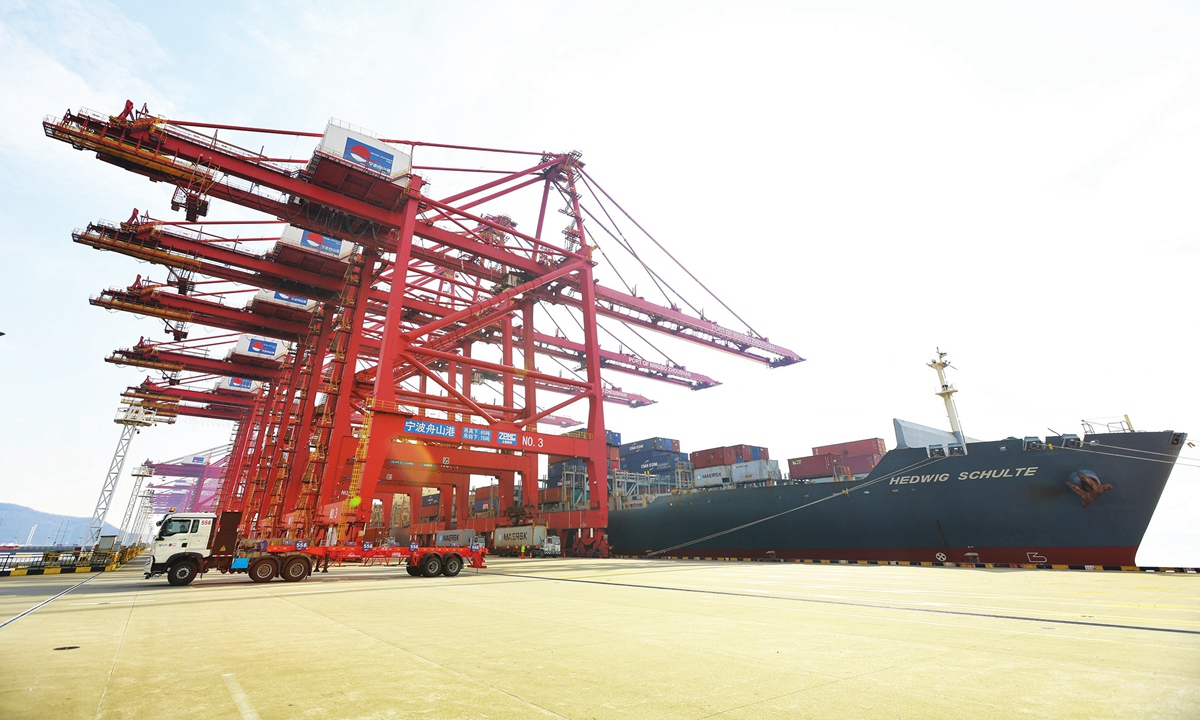
A view of the Dapukou terminal at the Ningbo Zhoushan Port, East China's Zhejiang Province on January 17, 2023 Photo: Li Hao/GT
Recently, market expectations for China's economic recovery from the impact of COVID-19 have been growing. The net inflow of capital into China's A-share market has continued to rise, and many international institutions have also raised their forecasts for China's economic growth, all indicating that investors and analysts are generally optimistic about rebounding China's economic growth this year.
The recovery of domestic demand across the Chinese economy is picking up momentum and economic fundamentals are improving. The economy is expected to recover to a potential growth level of 5-6 percent in 2023 with no excessive demands on policies. The economic recovery is expected to speed up in the third and fourth quarter of 2023.
According to the long-term goal, China's economic size and per capita income should double by 2035, and the average growth rate of China's GDP during the 14th Five-Year Plan period (2021-25) period should be at least 5 percent. That requires this year's economic growth rate should be as high as possible. Only in this way can it make up for the impact on economic growth caused by the epidemic last year. In view of the current situation, to achieve an economic growth target of more than 5 percent this year, the country still needs comprehensive, powerful and precise macro policies.
To maintain reasonable and sufficient market liquidity and provide continuous and sufficient financial support for the stabilization and recovery of economic operation, the prudent monetary policy is expected to continue to increase loose adjustment in 2023. Against the backdrop of China's imported inflationary pressures gradually easing as tightening policies in developed economies slow down, the room for looser adjustment of prudent monetary policy is expected to increase. During the year, China's central bank, the People's Bank of China, may carry out two cuts to reserve requirement ratio (RRR) in the first half and the second half of the year respectively, with each RRR cut at a rate of 0.25 percentage points.
This year investments are expected to play important role in expanding domestic demands. Infrastructure and manufacturing will continue to be key aspects of investments. The issuance of special-purpose bonds in 2023 will be at the similar level of 2022, and a batch of important projects will start construction. The growth rate of fixed asset investment for the whole year is expected to reach 5.5 percent, of which, the growth rate of infrastructure and manufacturing investment will reach 7.5 percent and 8 percent respectively.
The growth rate of real estate investment may still drop by 5 percent. In line with the long-standing policy plank of "houses are for living in, not for speculation," investments in the real estate sector is expected to pick up speed in the second half of the year. Housing prices in major cities are expected to stabilize and rise in the second quarter, and real estate investment will also bottom out before stabilizing.
With further optimization of the epidemic prevention and control measures and the intensifying policy support for consumption, improvement of consumer demand, improvement of the employment, rapid recovery of the service industry, orderly recovery of real estate sales, and recovery of auto sales will all promote consumption, which will become the top driving force for economic growth.
From a policy perspective, this year China will continue to do a good job in stabilizing employment and increasing the income of urban and rural residents through multiple channels. At the same time, various policies to boost consumption will be launched one after another. With the orderly recovery of the real estate market and a boost to auto sales, under a neutral scenario, total retail sales of consumer goods in 2023 is expected to achieve a growth rate of 7 percent. Under the optimistic and pessimistic scenarios, the growth rate of consumption for the whole year may be 8 percent respectively and 6 percent, respectively.
The global economy is facing downward pressure this year, and external demand is expected to slow down and contract. It is expected that China's exports will be under pressure throughout the year. However, there are also many positive factors on the export side. First, China's entire industrial chain system will continue to highlight its advantages. Second, the support of the Regional Comprehensive Economic Partnership and the reduction of manufacturing in Europe will bring structural opportunities to China's exports. Third, policy support for stabilizing foreign trade is expected to continue to increase this year.
The author is chief economist and head of the Zhixin Investment Research Institute. bizopinion@globaltimes.com.cn
